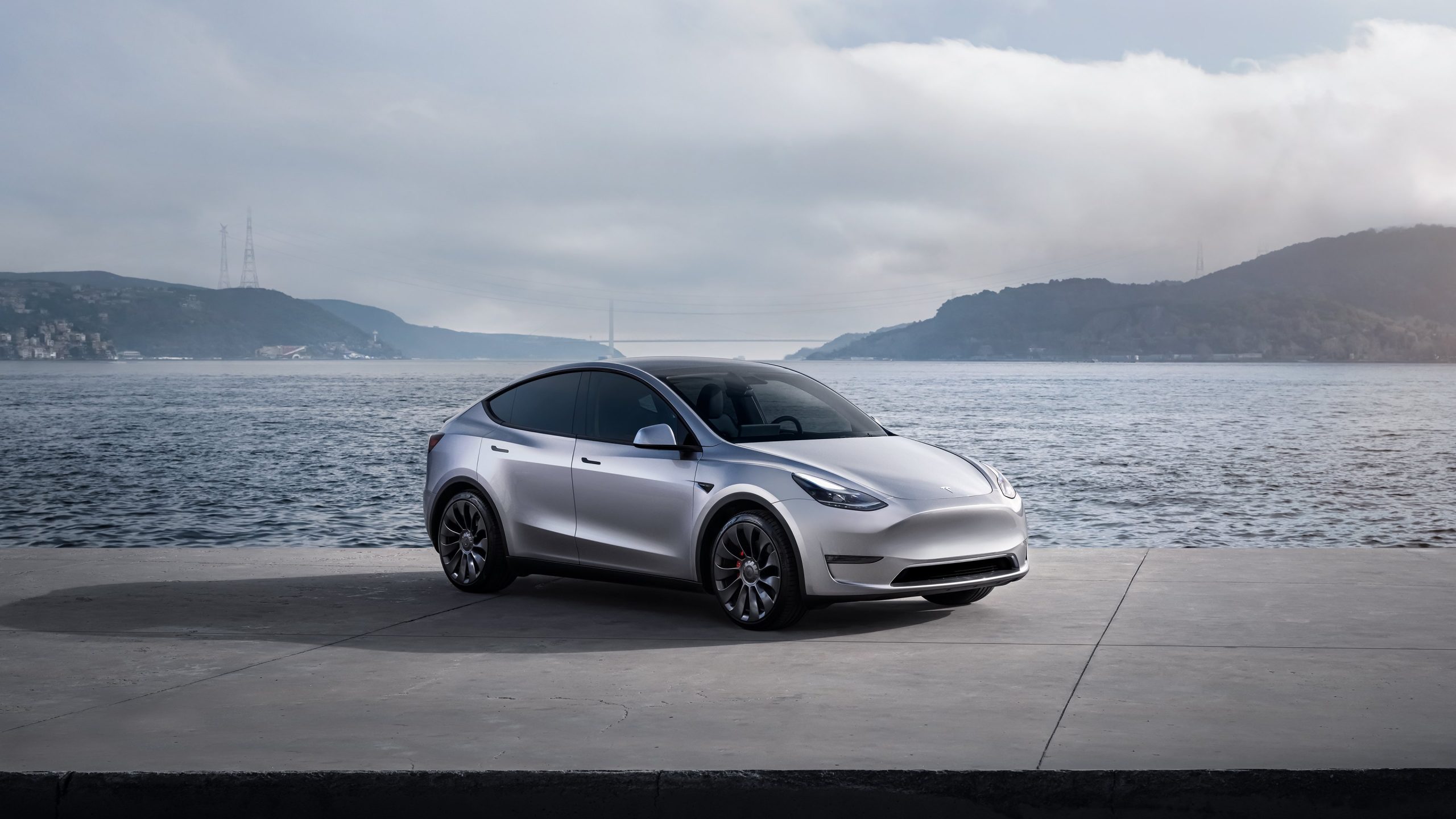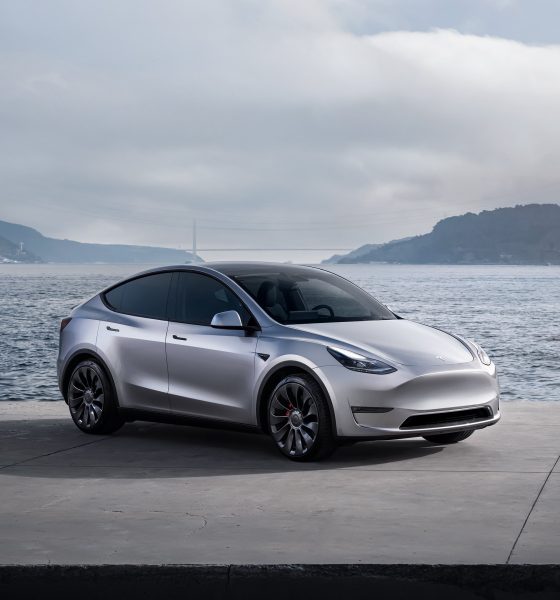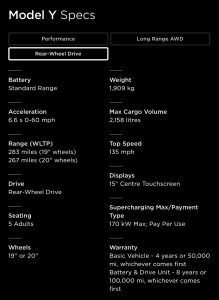

News
Updated: Tesla Model Y specification discrepancy has experts scratching their heads
Update: 5/3 12:40 pm est: Tesla has updated the specifications of the Model Y RWD in North America. See para. 3
A discrepancy in the Tesla Model Y’s specifications leaves experts and fans confused and wondering what will come to the United States.
Tesla has always been at least a little tight-lipped about its engineering and design, and this pseudo-secrecy certainly isn’t aided by its lack of a communications team. However, this has come to a head recently as fans have discovered a discrepancy in the specifications of Tesla’s newest offering, the rear-wheel-drive single-motor Model Y, which currently is only sold in select markets.
The Tesla Model Y spec discrepancy was first identified by Mathias Føns on Twitter, who pointed out that the Model Y RWD sold in North America is significantly heavier and charges substantially faster than its counterpart abroad.
The??Tesla Model Y RWD that recently launched has head-scratching specs
It weighs 319kg more than the??MY LR
Furthermore, it weighs 389kg more than the??MY RWD, has 47% higher max supercharging capabilities & ~15 km lower range (WLPT→EPA)
Did Tesla stealth launch new MY tech? pic.twitter.com/tYqoow7x4e
— Mathias Føns (@FonsDK) May 2, 2023
Since its discovery, Tesla has updated its website, decreasing the weight listed in North America to match the global model. However, the Model Y RWD outside of North America still charges at 170kW, while its North American counterpart charges at 250kW. Tesla has not publically addressed this disparity.
Looking at the spec sheets posted on Tesla websites worldwide, the heavier and faster charging Model Y RWD is only being sold in North America, including both Canada and Mexico, though the vehicle is not yet available in the States. In contrast, models sold in Australia, Europe, and Asia are lighter and charge significantly slower. Specifically, the North American model is 389kg (857.6 lbs) heavier than its global counterpart and charges almost twice as fast, 250kW vs. 170kW. The listed weight of the model sold in China is 2kg heavier than the one sold in Europe, but it has the same recorded charging speed.
The two models also seem to differ slightly in estimated range, though they aren’t precisely comparable considering they use entirely different testing schedules; EPA in North America, WLTP in Europe and Australia, and CLTC in China.
Strangely, this discrepancy continues when comparing the Model Y RWD with the Model Y Long-Range AWD sold in the same market. According to the Tesla Canada website, the RWD is 319kg (703.3 lbs) heavier than the LR AWD, though they charge at the same speed, 250kW.
While some have hypothesized that this weight difference has to do with how the weight is measured in each country, the more likely difference, which could also explain the dramatic difference in charging speed, is battery chemistry. Tesla does not list this difference on its website. Still, using lithium iron phosphate (LFP) batteries in North America would explain the incredible weight difference and the charging speed increase, that is, if the global model is using a lithium nickel manganese cobalt (NMC) battery.
Tesla CEO Elon Musk has previously noted that the automaker plans to switch all of its lower-priced offerings to the cheaper-to-produce LFP battery, further adding credence to the battery chemistry hypothesis.
With Tesla expected to continue to grow the reach of each of its product lines, many anticipate it will only be a matter of time before the RWD variant of the Model Y makes its way to Tesla’s home market, the United States. And with the rest of North America already using the heavier, faster charging model, Americans should expect access to this variant instead of the global version.
Along with the charging speed bump, the LFP battery would provide significantly improved durability and battery lifespan compared to those sold in Europe, Asia, and Australia.
What do you think of the article? Do you have any comments, questions, or concerns? Shoot me an email at william@teslarati.com. You can also reach me on Twitter @WilliamWritin. If you have news tips, email us at tips@teslarati.com!

News
Tesla FSD fleet is nearing 7 billion total miles, including 2.5 billion city miles
As can be seen on Tesla’s official FSD webpage, vehicles equipped with the system have now navigated over 6.99 billion miles.

Tesla’s Full Self-Driving (Supervised) fleet is closing in on almost 7 billion total miles driven, as per data posted by the company on its official FSD webpage.
These figures hint at the massive scale of data fueling Tesla’s rapid FSD improvements, which have been quite notable as of late.
FSD mileage milestones
As can be seen on Tesla’s official FSD webpage, vehicles equipped with the system have now navigated over 6.99 billion miles. Tesla owner and avid FSD tester Whole Mars Catalog also shared a screenshot indicating that from the nearly 7 billion miles traveled by the FSD fleet, more than 2.5 billion miles were driven inside cities.
City miles are particularly valuable for complex urban scenarios like unprotected turns, pedestrian interactions, and traffic lights. This is also the difference-maker for FSD, as only complex solutions, such as Waymo’s self-driving taxis, operate similarly on inner-city streets. And even then, incidents such as the San Francisco blackouts have proven challenging for sensor-rich vehicles like Waymos.
Tesla’s data edge
Tesla has a number of advantages in the autonomous vehicle sector, one of which is the size of its fleet and the number of vehicles training FSD on real-world roads. Tesla’s nearly 7 billion FSD miles then allow the company to roll out updates that make its vehicles behave like they are being driven by experienced drivers, even if they are operating on their own.
So notable are Tesla’s improvements to FSD that NVIDIA Director of Robotics Jim Fan, after experiencing FSD v14, noted that the system is the first AI that passes what he described as a “Physical Turing Test.”
“Despite knowing exactly how robot learning works, I still find it magical watching the steering wheel turn by itself. First it feels surreal, next it becomes routine. Then, like the smartphone, taking it away actively hurts. This is how humanity gets rewired and glued to god-like technologies,” Fan wrote in a post on X.
News
Tesla starts showing how FSD will change lives in Europe
Local officials tested the system on narrow country roads and were impressed by FSD’s smooth, human-like driving, with some calling the service a game-changer for everyday life in areas that are far from urban centers.

Tesla has launched Europe’s first public shuttle service using Full Self-Driving (Supervised) in the rural Eifelkreis Bitburg-Prüm region of Germany, demonstrating how the technology can restore independence and mobility for people who struggle with limited transport options.
Local officials tested the system on narrow country roads and were impressed by FSD’s smooth, human-like driving, with some calling the service a game-changer for everyday life in areas that are far from urban centers.
Officials see real impact on rural residents
Arzfeld Mayor Johannes Kuhl and District Administrator Andreas Kruppert personally tested the Tesla shuttle service. This allowed them to see just how well FSD navigated winding lanes and rural roads confidently. Kruppert said, “Autonomous driving sounds like science fiction to many, but we simply see here that it works totally well in rural regions too.” Kuhl, for his part, also noted that FSD “feels like a very experienced driver.”
The pilot complements the area’s “Citizen Bus” program, which provides on-demand rides for elderly residents who can no longer drive themselves. Tesla Europe shared a video of a demonstration of the service, highlighting how FSD gives people their freedom back, even in places where public transport is not as prevalent.
What the Ministry for Economic Affairs and Transport says
Rhineland-Palatinate’s Minister Daniela Schmitt supported the project, praising the collaboration that made this “first of its kind in Europe” possible. As per the ministry, the rural rollout for the service shows FSD’s potential beyond major cities, and it delivers tangible benefits like grocery runs, doctor visits, and social connections for isolated residents.
“Reliable and flexible mobility is especially vital in rural areas. With the launch of a shuttle service using self-driving vehicles (FSD supervised) by Tesla in the Eifelkreis Bitburg-Prüm, an innovative pilot project is now getting underway that complements local community bus services. It is the first project of its kind in Europe.
“The result is a real gain for rural mobility: greater accessibility, more flexibility and tangible benefits for everyday life. A strong signal for innovation, cooperation and future-oriented mobility beyond urban centers,” the ministry wrote in a LinkedIn post.
News
Tesla China quietly posts Robotaxi-related job listing
Tesla China is currently seeking a Low Voltage Electrical Engineer to work on circuit board design for the company’s autonomous vehicles.

Tesla has posted a new job listing in Shanghai explicitly tied to its Robotaxi program, fueling speculation that the company is preparing to launch its dedicated autonomous ride-hailing service in China.
As noted in the listing, Tesla China is currently seeking a Low Voltage Electrical Engineer to work on circuit board design for the company’s autonomous vehicles.
Robotaxi-specific role
The listing, which was shared on social media platform X by industry watcher @tslaming, suggested that Tesla China is looking to fill the role urgently. The job listing itself specifically mentions that the person hired for the role will be working on the Low Voltage Hardware team, which would design the circuit boards that would serve as the nervous system of the Robotaxi.
Key tasks for the role, as indicated in the job listing, include collaboration with PCB layout, firmware, mechanical, program management, and validation teams, among other responsibilities. The role is based in Shanghai.
China Robotaxi launch
China represents a massive potential market for robotaxis, with its dense urban centers and supportive policies in select cities. Tesla has limited permission to roll out FSD in the country, though despite this, its vehicles have been hailed as among the best in the market when it comes to autonomous features. So far, at least, it appears that China supports Tesla’s FSD and Robotaxi rollout.
This was hinted at in November, when Tesla brought the Cybercab to the 8th China International Import Expo (CIIE) in Shanghai, marking the first time that the autonomous two-seater was brought to the Asia-Pacific region. The vehicle, despite not having a release date in China, received a significant amount of interest among the event’s attendees.











